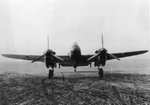FLYBOYJ
"THE GREAT GAZOO"
This might have been true as I do know there was also 'rumor' that along with these engine proposals was a proposal to get rid of the yoke and go with a stick. I read somewhere that during an interview Kelly Johnson was quoted verifying this, but again never found any documented proof of these proposals.For FlyboyJ:
How true it is I don't know but in the book "Vee's for Victory" the author describes 2 if not 3 different P-38/Merlin proposals. In no case does it make any real difference to performance (except in some cases the Merlin versions had shorter estimated range). These are all paper studies.
How much difference it would have made to maintenance or service issues I don't know.
For the early part of the war the P-38 was the ONLY premier US fighter and was in chronic short supply in all theaters. Delays in production would have seriously hampered US efforts at the time.
When the Burbank facility was shut down in 1990, there were tons of old documents tossed. Buried benith those piles was probably the answer we are now looking for.


